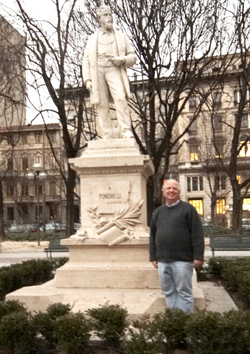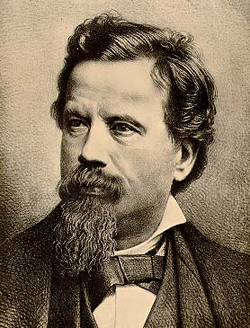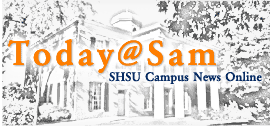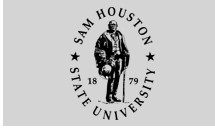SHSU Music Professor is Ponchielli Detective
 |
Howey with Ponchielli
Statue in Cremona. |
Amilcare Ponchielli lived, composed, and performed in Italy
from about 1856 until his death at the age of 52 in 1886.
In 1876 he wrote La Gioconda, his one great opera.
Within it is the Dance of the Hours, which even
non-opera fans recognize as the hippo dance in Walt Disney's
Fantasia. He had one student who outdid him as a
composer--Giacomo Puccini.
So why would Sam Houston State University music professor
Henry Howey find him of such interest that he has spent 13
years and an estimated $40,000 of his own money studying Ponchielli?
One reason, perhaps, is that Ponchielli is a hybrid. He
made his living writing and performing band music for 13 years,
yet is most famous for that one opera and that one student.
To someone who studies how the public band movement began,
in Italy, Germany, England, and the United States, that can
pique an interest.
We have heard of the Big Band Era of the 1930s and 40s,
but even a century earlier bands were playing music for the
common folk.
Bands were often composed of amateurs. Even those who were
professionals, like Ponchielli, had to relate to and interact
with everyday people and their lives.
Howey is probably the world's foremost authority on the
funeral marches of Ponchielli. He said that Ponchielli and
his band sometimes performed at up to 40 funerals in a year,
many for infants and children.
The funeral music that Ponchielli wrote was "bright and
clear," Howey said. It had to be to sound good as the musicians
marched and played through the narrow streets of the small
Italian towns.
With so many immigrants coming to America from countries
where bands were known, it is no surprise that outdoor bandstands
and band music were considered to be for those who could not
afford tickets to the great concert halls.
Boston music journalist John Sullivan Dwight wrote in 1868
that "the common people are the listeners to the concerts
on the Common," unlike "the class who patronize the great
organ, the opera and the oratorio."
It is a tradition that continues, in Huntsville, Texas,
even, on March 23, 2006. The U. S. Air Force Band will give
a free concert at 7 p.m. that evening at Sam Houston State
University's Johnson Coliseum, sponsored by the Huntsville
Item.
Audience members can get tickets early at the Item for premium
seating, or show up 15 minutes beforehand for general admission.
The fact that the band that performs Thursday is connected
to the military is also no accident. John Phillip Sousa, who
wrote marches for the Marine Band, is America's best-known
pre-Big Band Era bandmaster. Many of the men who played in
Sousa's band were Italian immigrants, trained in the Ponchielli
style, Howey discovered.
And even before Sousa, bands were important to the military,
to both sides during the Civil War. Bands even took their
music into the trenches.
Lieutenant S. Millett Thompson of the 13th Regiment of New
Hampshire described an incident occurring just after the battle
of Cold Harbor on June 8, 1864:
"This evening the Band of the Thirteenth goes into the trenches
at the front, and indulges in a 'competition concert' with
a band that is playing over across in the enemy's trenches,"
Thompson recorded in his diary.
"The enemy's Band renders Dixie, Bonnie Blue
Flag, My Maryland, and other airs dear to the
Southerner's heart. Our Band replies with America,
Star Spangled Banner, Old John Brown, etc.
"After a little time, the enemy's band introduces another
class of music; only to be joined almost instantly by our
Band with the same tune.
"All at once the band over there stops, and a rebel battery
opens with grape. Very few of our men are exposed, so the
enemy wasted his ammunition; while our band continues its
playing, all the more earnestly until all their shelling is
over."
Howey knows the military band business first hand. He earned
bachelor's and master's degrees at the University of Illinois
and his doctorate at the University of Iowa and served with
The United States Army Band in Washington, D.C. before coming
to SHSU in 1976.
Primarily a trombonist, he also performs on euphonium and
tuba with the Sam Houston Brass Quintet, which he founded.
He has also used his knowledge of computer technology and
the Italian language as keys to his research efforts. Band
music and its heroes, like Ponchielli, are not appreciated,
he said.
"The band has been under-represented in the realm of music
history," said Howey. "Its role in the popular dissemination
of music has been accorded a second place due to its public
and patriotic functions."
In the 19th century Italian bands were the source of popular
entertainment and education, spreader of civil values and
the ideas in a movement for Italian unification. Now with
radio, television, satellite networks, compact discs and such,
there is a danger that it will be all but forgotten.
Howey's work began after an Italian music historian named
Licia Sirch prepared a catalog of music thought to be mainly
operatic in scope. She became aware of a paper Howey had presented
in Paris at a meeting of the Historic Brass Society, and invited
him to a program on Ponchielli's band music that was being
held in Italy.
Howey began making trips to Italy, poring over published
concert programs, primarily in small town newspapers. He came
up with about 400 titles that had been performed, and through
what he has described as "a sort of detective story," has
"found" some 200 of them.
Much of the work has been done at the state library, the
Biblioteca Statale, and the School of Musicology and Philology
of the University of Pavia in Cremona, Italy.
 |
"Capo-Bando"
Amilcare Ponchielli |
Ponchielli was the capo-bando -- the chief of the
band, the maestro, the master--in Piacenza and Cremona from
1861 to 1873.
Howey estimates Ponchielli was paid the equivalent of $60,000-$80,000
per year, and was responsible for preparing music, for rehearsing,
and for performing. His musicians were paid the equivalent
of $20,000 per year, and had other jobs as well. One of their
primary duties was to teach young musicians.
The work was hectic, especially in the performance-packed
days of April to September, before computers, copy machines
and inkjet printers. When Ponchielli would complete a piece,
it would be hand-copied by a "copyist/editor."
Some "autograph" or composer first edition manuscripts,
and especially copies of compositions, are unclear. Whether
a note was on a line or in a space, for instance, can be difficult
to determine.
Howey has made great use of his digital camera to show the
actual work of Ponchielli and enlarging the digital images
to help decide note position questions.
"A computer software program called Finale can reproduce
sounds so a wrongly interpreted note in one part can be heard,
and the remainder of the score can be used to find a double
of the note in error," Howey explained.
"When no doubling is found, the harmonic context provides
the means to make the 'line or space' controversy disappear."
Sometimes it takes photographic trickery to uncover the
whole truth.
"Ponchielli often filled the margins of a page with notes,"
said Howey. "When the longest cadenza in the work was covered
at a later date by someone binding the score, the 'hidden'
notes reappeared only when this scrap was photographed with
a light source behind it."
Howey has found other "mistakes," notes that he knows because
of his familiarity with Ponchielli's composition patterns
were recorded incorrectly by a transcriber, or by Ponchielli
himself.
Among Howey's credits is a chapter in Sirch's book, Ponchielli
e la musica per banda, entitled Death in Cremona:
Ponchielli's Funeral Marches for Band.
Sirch thanked him in the foreword of that book "for having
given us his technological and musical know-how--especially
his database and his fabulous digital transcriptions before
they were published."
He and Sirch co-authored an online article entitled The
Doctrine of a Critical Edition of the Band Music of Amilcare
Ponchielli, complete with "autograph" scores to view
and sound files to hear. That article is at http://philomusica.unipv.it/annate/2004-5/intro.html.
Publication of a critical edition of a music figure's work
is the ultimate accomplishment for a music historian, and
as the online article suggests, Howey is well his way to completing
that task. He has applied for a National Endowment for the
Humanities grant to enable him to complete a critical edition
on Ponchielli.
Even if that should not happen, Howey's Ponchielli detective
story has been professionally gratifying. This past week,
while many of his colleagues and students were on spring break,
he was teaching a course at the University of Pavia's Musicology
School.
While he is not of Italian descent, Howey has certainly
become a fan of that culture as well as Amilcare Ponchielli.
"He was denied a place in opera history by his premature
death," said Howey. "It is only right that he should be remembered
by a repertoire he wrote for the first citizens of a new Italy,
full of hope, patriotism, and Italy's gift to the world--music."
—END—
SHSU Media Contact: Frank
Krystyniak
March 20, 2006
Please send comments, corrections, news tips to Today@Sam.edu.
|


